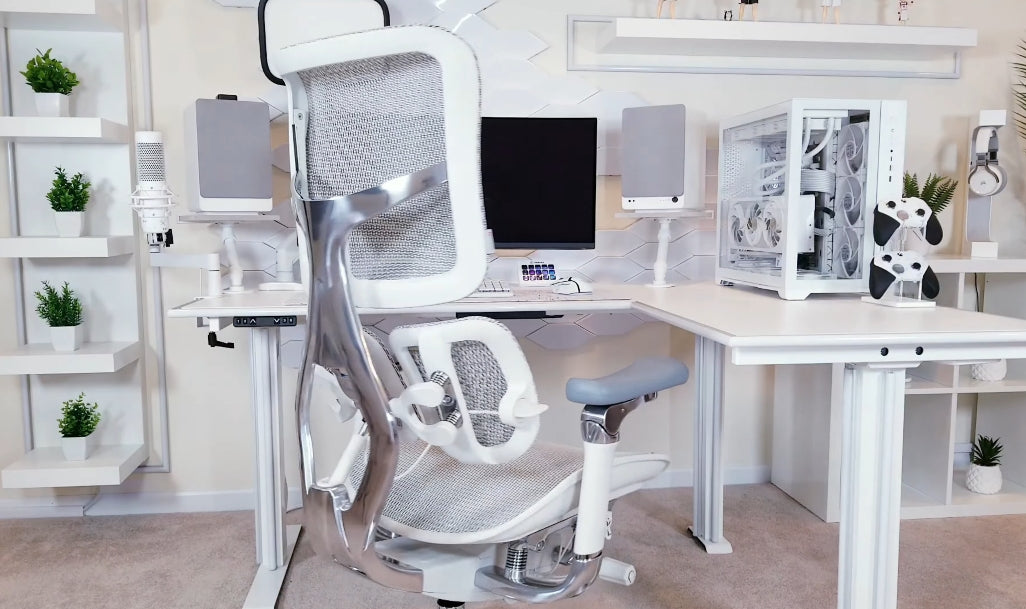Adjustable standing desks have become a popular solution for those looking to combat the health risks associated with prolonged sitting. The ability to switch between sitting and standing during the workday can boost productivity, reduce fatigue, and improve posture. However, simply owning a standing desk isn’t enough—it’s essential to find the correct height to maximize comfort and efficiency.
Setting the wrong height for your adjustable standing desk can lead to discomfort and even strain in your back, neck, shoulders, or wrists. To make the most out of your desk, it’s crucial to fine-tune it to the perfect ergonomic position for both sitting and standing. Here's a guide to help you adjust your standing desk to the ideal height.
Understand the Basics of Ergonomics
Before diving into the specifics of adjusting your desk height, it’s important to grasp the fundamentals of ergonomics. Ergonomics refers to designing or arranging workspaces to suit human body mechanics. For standing desks, this means finding a position that minimizes strain on your body while optimizing productivity.
Your desk height should allow you to maintain a neutral posture, where your body is aligned in a way that reduces stress on muscles and joints. This involves keeping your spine straight, shoulders relaxed, and wrists in a neutral position.
Set Your Desk Height for Standing
When standing at your desk, the key is to avoid leaning, slouching, or overreaching. Follow these steps to find the perfect standing height:
a) Start by Standing Upright
Stand up straight with your feet shoulder-width apart. Your posture should be natural and relaxed—avoid slouching or leaning.
b) Elbows at a 90-Degree Angle
Your elbows should be bent at a 90-degree angle when your hands are on the keyboard. This angle is crucial because it minimizes strain on your arms and shoulders. If the desk is too low, you’ll find yourself hunching over; if it’s too high, you’ll raise your shoulders, which can cause tension over time.
c) Monitor at Eye Level
Once your keyboard is at the right height, adjust your monitor so that the top of the screen is at or slightly below eye level. This allows you to keep your neck in a neutral position, reducing strain on your neck and shoulders. You shouldn’t have to tilt your head up or down to see the screen comfortably.
d) Maintain a Neutral Wrist Position
Your wrists should remain straight, not bent upwards or downwards, while typing. An ergonomic wrist angle prevents repetitive stress injuries like carpal tunnel syndrome. If necessary, use a wrist rest for extra support.
Set Your Desk Height for Sitting
An adjustable standing desk can also be lowered to a sitting position, and it’s just as important to have the right ergonomic setup while sitting. Here’s how to ensure your desk is set to the perfect height for sitting:
a) Sit in an Ergonomic Chair
Start by sitting in an ergonomic chair that supports your lower back. Your feet should be flat on the ground or on a footrest, with your knees bent at a 90-degree angle. This will help maintain a neutral spine position.
b) Elbows at a 90-Degree Angle
Just like when standing, your elbows should be at a 90-degree angle when your hands are on the keyboard. If the desk is too high, it will cause tension in your shoulders. If it's too low, you’ll hunch over, leading to poor posture.
c) Monitor at Eye Level
Again, your monitor should be positioned so that the top of the screen is at or slightly below eye level. You want to avoid looking up or down, as this can strain your neck and shoulders.
Test and Fine-Tune Your Setup
After making initial adjustments to your desk height, take some time to test it out. Stand or sit at your desk for 10-15 minutes and assess how your body feels. Pay attention to any discomfort or tension in your back, neck, or wrists.
If something feels off, fine-tune the height of your desk until it feels comfortable. For example, if you notice your shoulders are tense while standing, try lowering the desk slightly. If your wrists feel strained while typing, consider adjusting the height to allow for a more neutral wrist position.
Take Breaks and Move Regularly
Even with the perfect standing desk setup, it's essential to take regular breaks and move throughout the day. Experts recommend following the 20-8-2 rule: for every 30 minutes, spend 20 minutes sitting, 8 minutes standing, and 2 minutes moving. This balance helps prevent fatigue and promotes circulation.
Consider Desk Accessories for Added Comfort
To further enhance your ergonomic setup, consider adding a few accessories to your standing desk:
- Anti-fatigue mat: If you spend long periods standing, an anti-fatigue mat can reduce pressure on your feet and legs, making it more comfortable to stand for extended periods.
- Monitor arm: A monitor arm allows for greater flexibility in positioning your screen at the right height and distance.
- Footrest: When sitting, a footrest can help keep your feet flat and support a comfortable seated posture.
- Keyboard tray: A keyboard tray can help you maintain the right typing position without having to raise or lower the desk too frequently.
Adjust Over Time
Finally, remember that your body’s needs may change over time. Regularly reassess your standing desk height and posture. Whether you change shoes, start using new accessories, or simply feel different after long hours at the desk, small adjustments can help keep you comfortable and productive.
Conclusion
Finding the perfect height for your height adjustable standing desk is essential for staying comfortable and healthy while working. By following these steps, you can create an ergonomic workspace that minimizes strain and maximizes productivity. Whether sitting or standing, ensuring proper posture will help you avoid discomfort and stay focused throughout the day. So take the time to fine-tune your setup and enjoy the benefits of a perfectly adjusted standing desk!



































